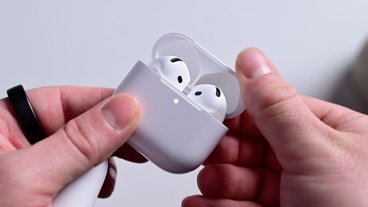With multiple product updates all arriving at once, many might have been overwhelmed by Apple's MacBook launch to overlook potentially important features and limitations — including the need to log out to switch graphics chips and the multiple party tricks of the new 24-inch Cinema Display.
While Apple's new MacBook Pro potentially delivers longer battery life by switching to integrated video instead of its more powerful discrete chipset, Apple notes in a support document that users can't just flick a switch and trigger the new mode.
Instead, changing energy preferences to favor either better battery life (with the GeForce 9400M) or faster performance (with the 9600M GT) prompts the notebook's owner to log out and back in for the change to take effect. It's not known whether disconnecting or reattaching power makes the switch automatically.
On the upside, however, the glass trackpad has brought about a major overhaul of Apple's control options for its multi-touch gestures. As tested by Gearlog earlier on Tuesday, the surface is now much more customizable: long-time owners clinging to pre-defined surface controls can specify a particular point of the pad that serves as a right-click. It's also possible to use a two-finger tap to right-click or to hold them and use them to zoom into a too-small portion of the display.
The four-finger gestures are hardwired to Expose (up and down) and to the app switcher (left and right).
And while many will find much to complain of with glossy displays and missing FireWire on the 13-inch model, some buyers may yet have surprises in store.
When comparing the features of the 2GHz and 2.4GHz MacBooks, Apple chief Steve Jobs described only the 2.4GHz model as having a backlit keyboard. Those ordering the basic model, however, are still asked to choose between backlit-only keyboard options. Whether this is a simple website error or a last-minute upgrade hasn't been confirmed.
Also up in the air is the memory ceiling. Officially, Apple supports no more than 4GB. However, the DDR3 notebook memory necessary for an upgrade is readily available in individual 4GB sticks, theoretically permitting a well-heeled owner to load the MacBooks with as much as 8GB of RAM. Without posted support documents or technical information from NVIDIA, though, it's difficult to tell whether it's an artificial or hard-coded limit Apple mentions.
24-inch LED Cinema Display
Apple's first DisplayPort monitor actually underuses the specification. Although it shares HDMI's ability to pipe audio alongside the video signal, Apple doesn't enable the speakers, iSight camera or mic until the USB cable is plugged into a notebook.
That speaker system is 2.1-channel — indicating the presence of a subwoofer.
So far, Apple is the only company to include a built-in power connector to recharge a notebook without resorting to its distinct power supply.
The firm is unusually cautious in its display claims. In spite of the LED backlighting and modern panel, Apple lists a comparatively modest 1,000:1 contrast ratio and a 14ms typical pixel response time. Most LCD display makers usually try to shrink this last figure by quoting only the very quick gray-to-gray times rather than white-to-black or other more realistic performance levels.
DisplayPort should play a role in all Macs going forward, so the Cinema Display should be usable with all upcoming Macs for the foreseeable future.
Apple execs at the event's Q&A
As is often the case at Apple's on-campus events, executives held a question and answer session with the press to address lingering concerns after the event.
In Tuesday's discussion, Apple cleared the air regarding Blu-ray, which was briefly rumored to be part of the new MacBook update but didn't materialize in the end. Notably, company co-founder Steve Jobs didn't address the HD format's absence in technical terms or as a matter of interest in defending iTunes. Instead, licensing hurdles have played the central role.
"Blu-ray is a bag of hurt. I don’t mean from the consumer point of view," Jobs said at the event. "It’s great to watch movies, but the licensing is so complex. We’re waiting until things settle down, and waiting until Blu-ray takes off before we burden our customers with the cost of licensing."
Separate questions also justified Apple's other technical decisions for the MacBook series. Even though it's favorable for home theaters, HDMI was left out as it normally doesn't support the 30-inch Cinema Display's 2560x1600 resolution. The company also resisted using a matte display by insisting that LED meant more light would pass through and overcome the gloss; a hinged display and portability also help.
NVIDIA should also play a larger role in Apple's platform for the future.
And in a preemptive strike against likely jittery investors looking for reassurances, Jobs began the Q&A by immediately stating that his blood pressure measured 110 over 70 — and that he wouldn't discuss his health beyond that point.
 Katie Marsal
Katie Marsal






-m.jpg)






 Amber Neely
Amber Neely
 Andrew Orr
Andrew Orr

 Sponsored Content
Sponsored Content

 William Gallagher
William Gallagher









96 Comments
I think the new Cinema Display would be perfect for a new Mac Mini! It would eliminate the "brick" power supply and make for a nice, clean setup.
I think the Bluray problem is cost not a legal issue. I think it's Jobs's "gentle" way of saying it costs too much.
With regards to the memory, the question is if the chipset supports more than 4GB of memory.
Also where does AI get its pictures from? I can't find any good pics of the new machines.
They reduced the educational discounts as well from $100 to $50 for the MB base model, $200 to $100 for the the 2.4GHz MBP. I guess they really reduce their margins on those computers.
Any word on Firewire over Ethernet?
The new trackpad looks really cool. I guess it actually moves when you "click" it, so you get feedback and you can't accidentally click it.